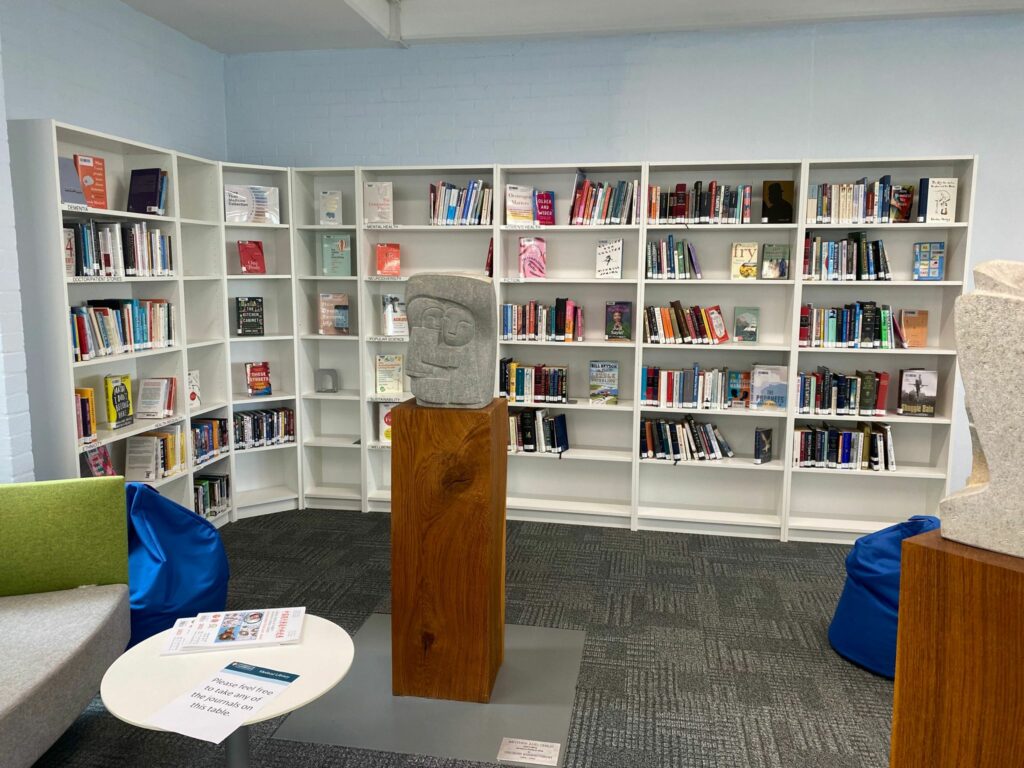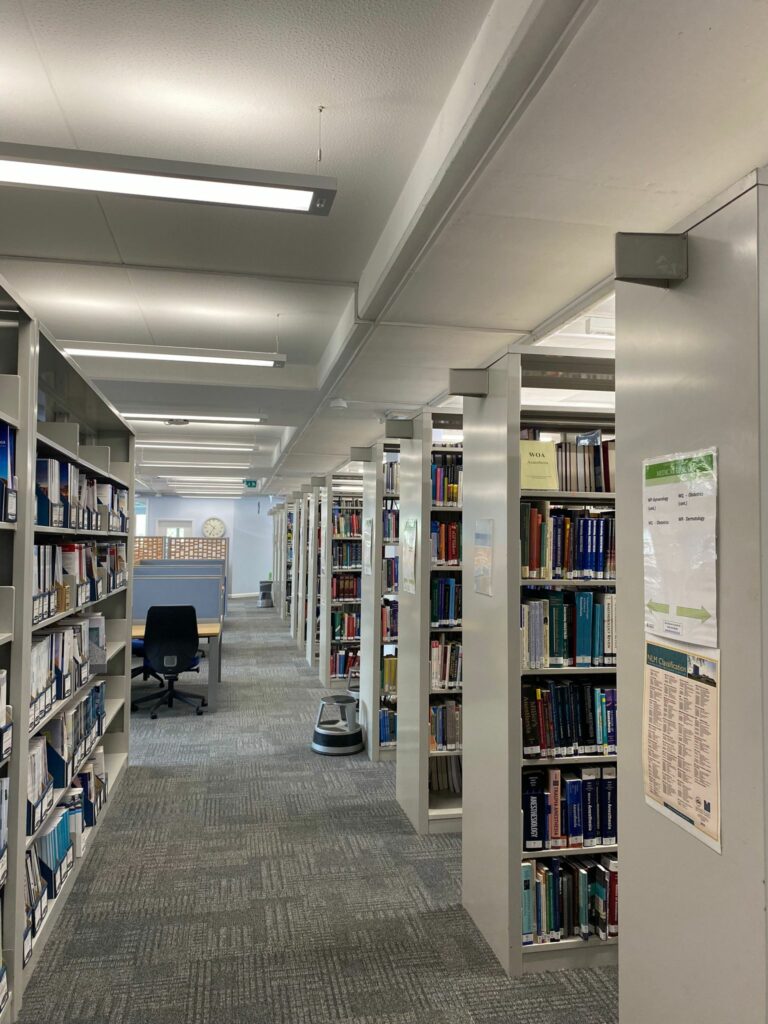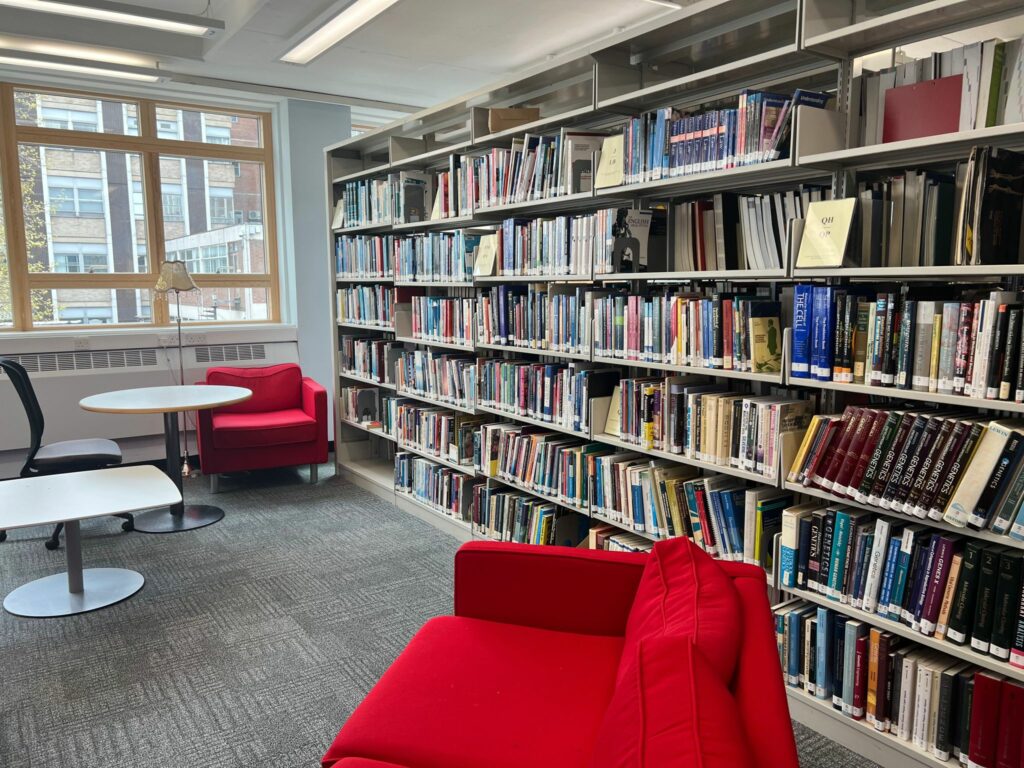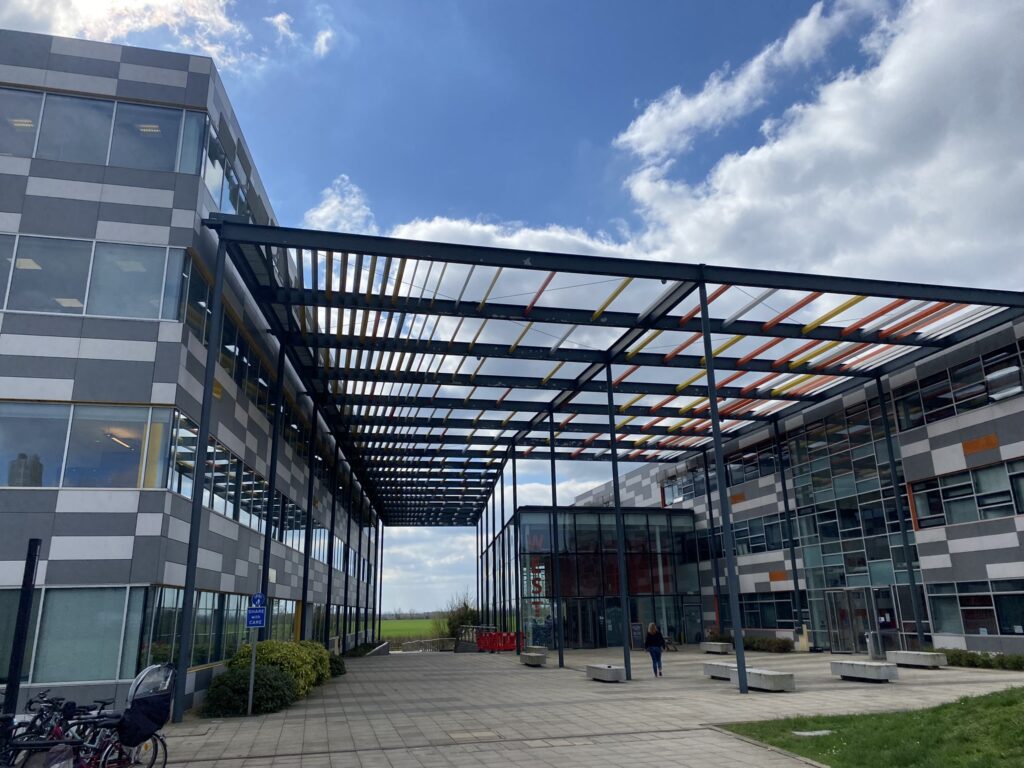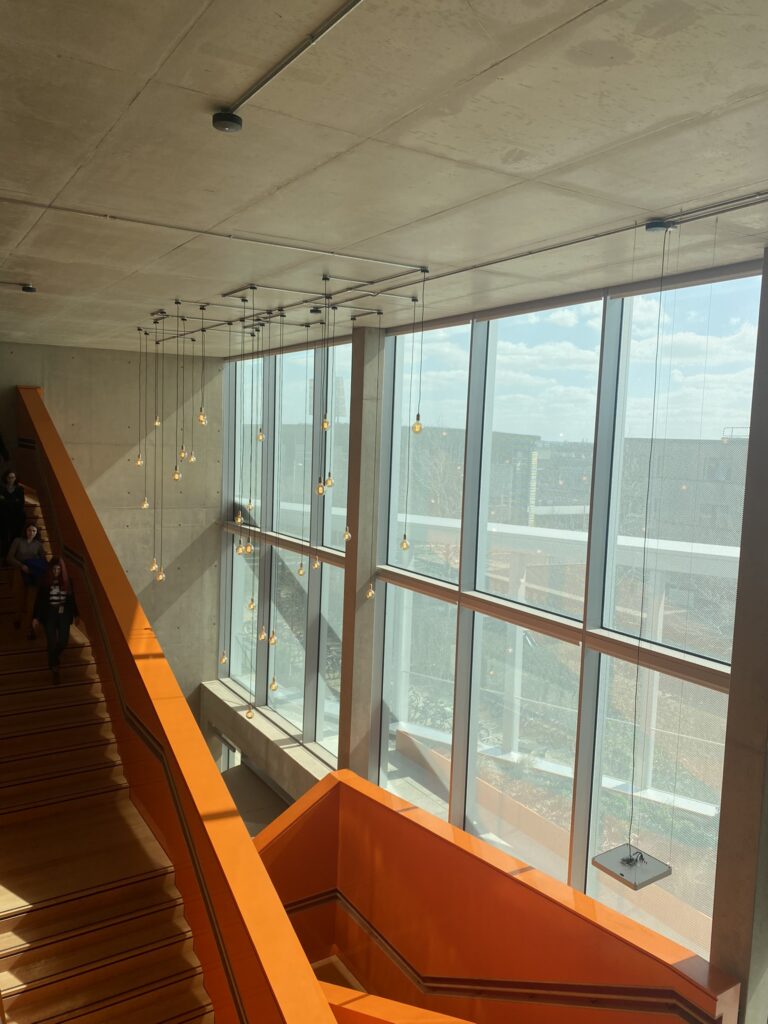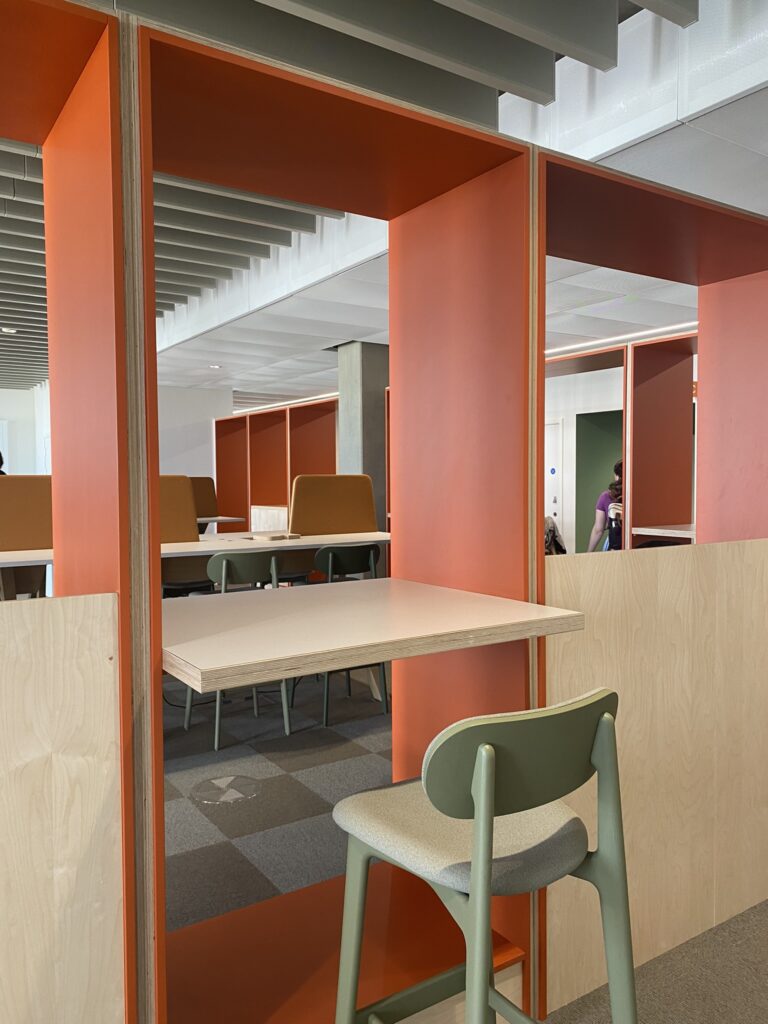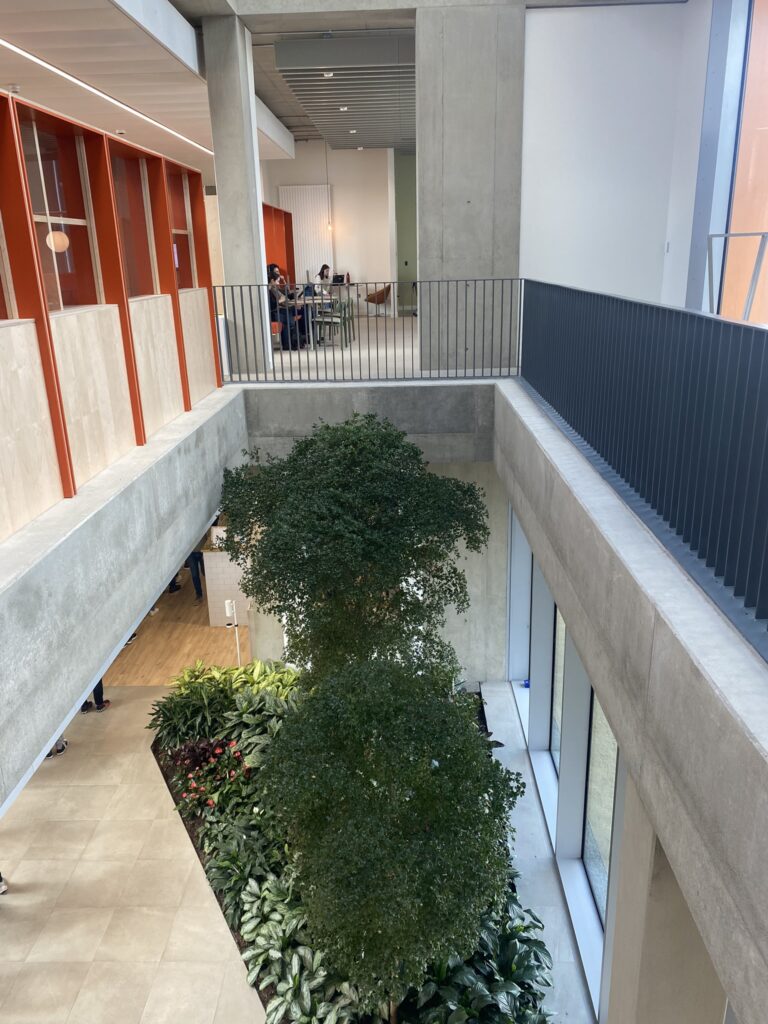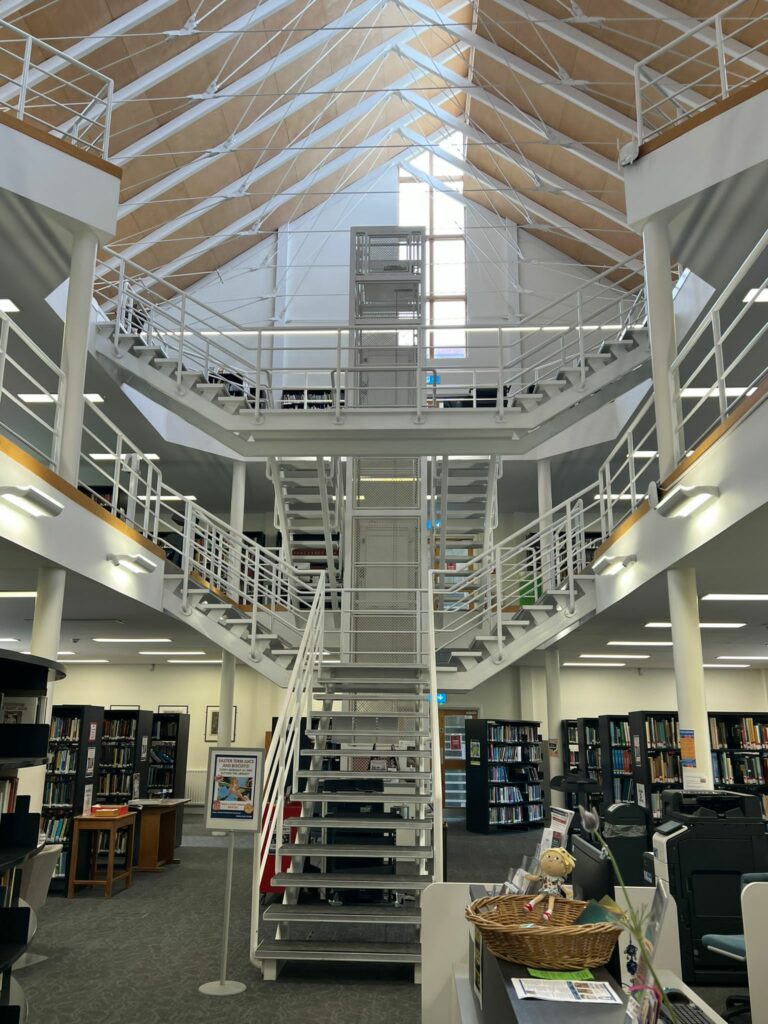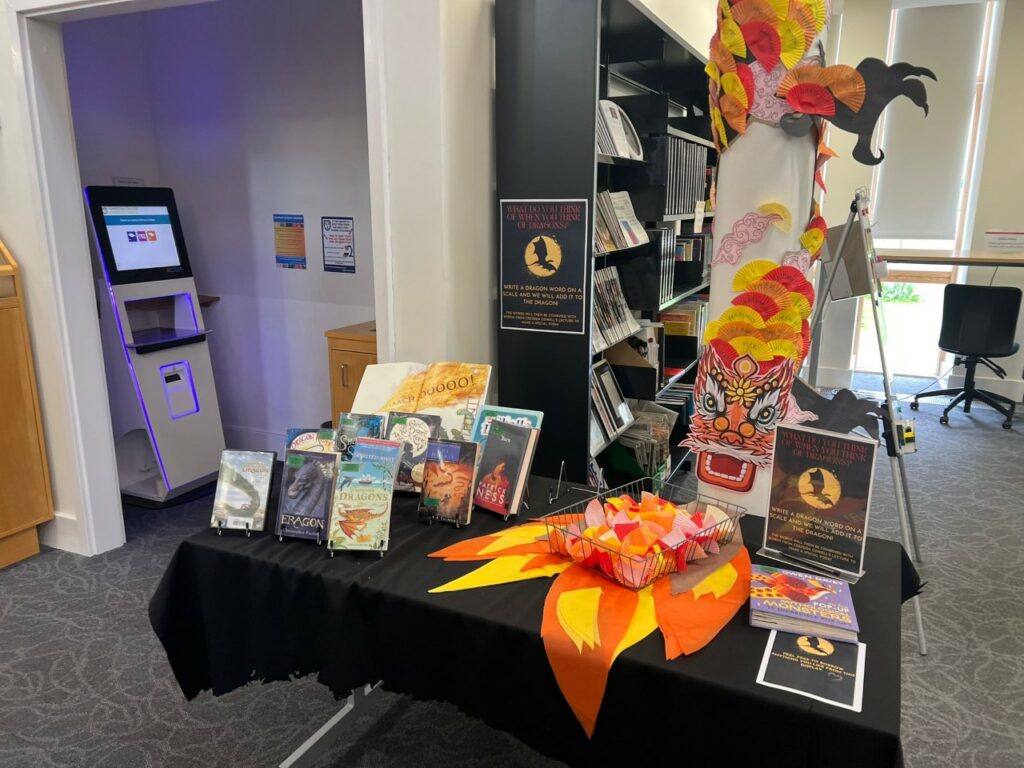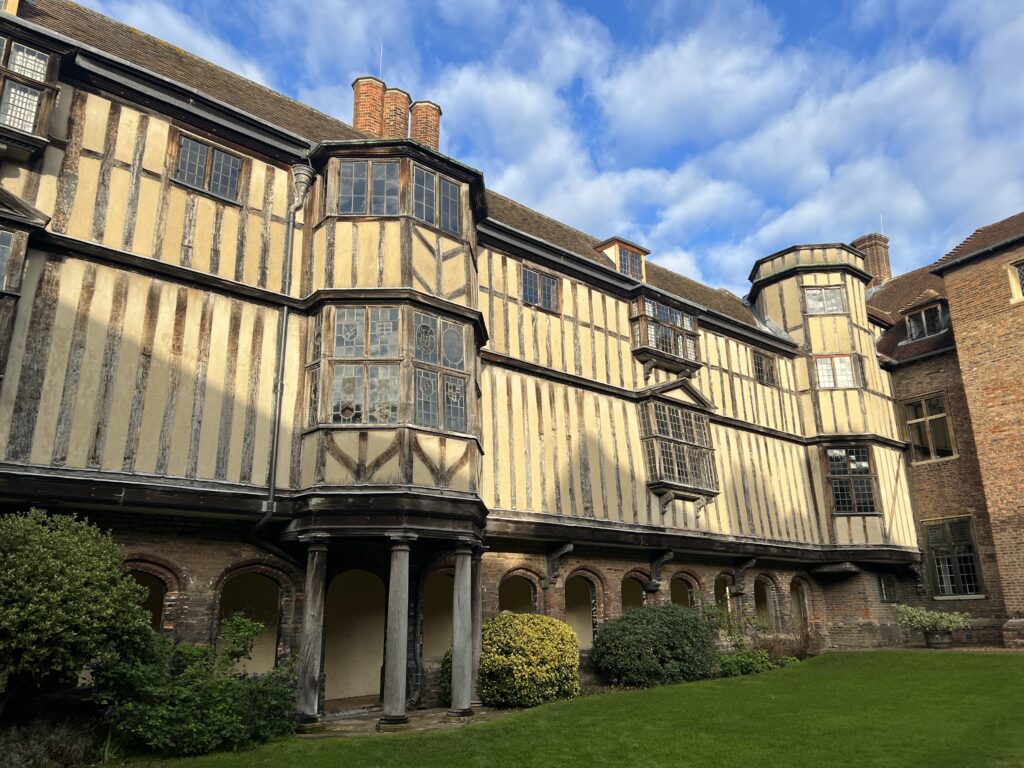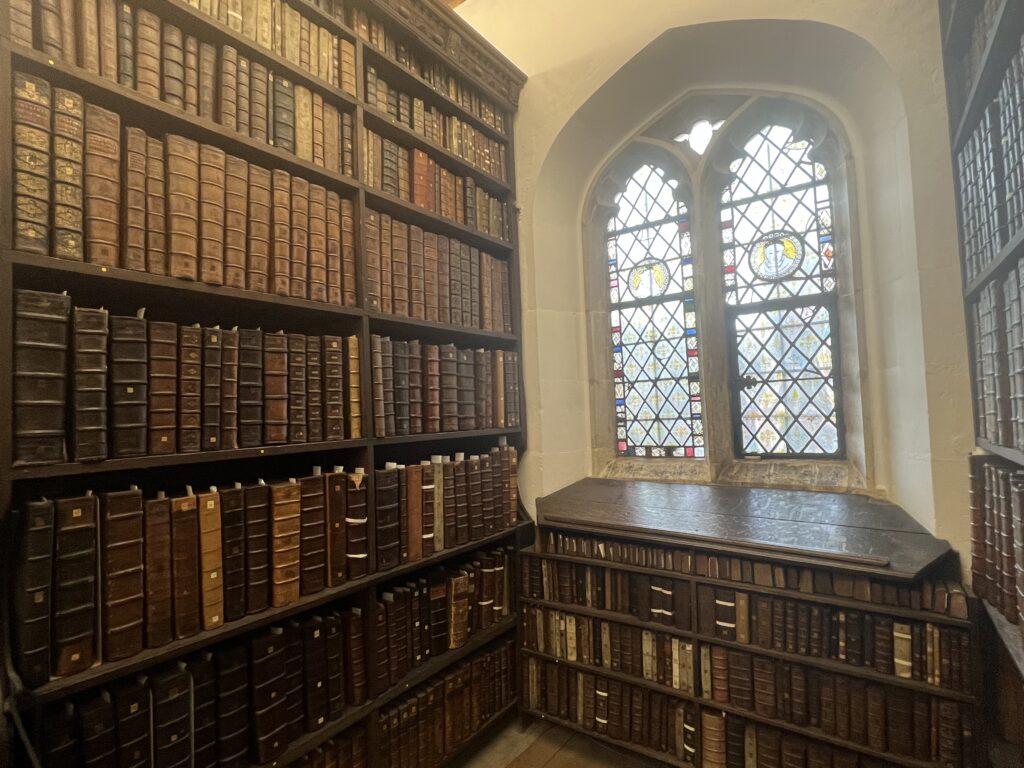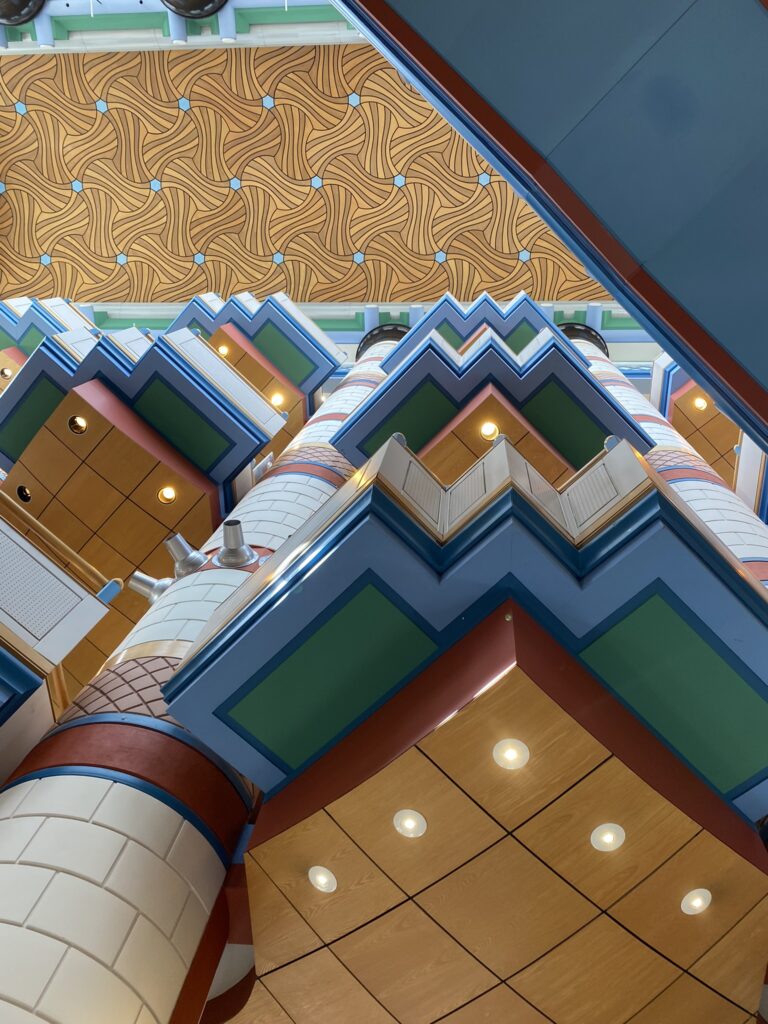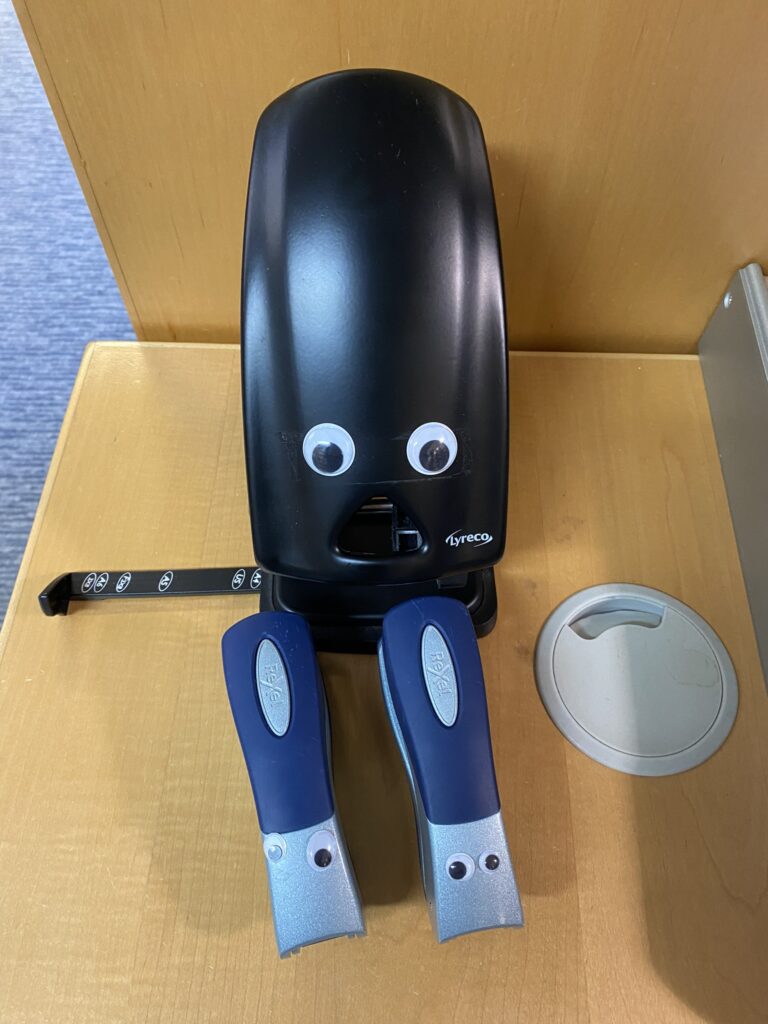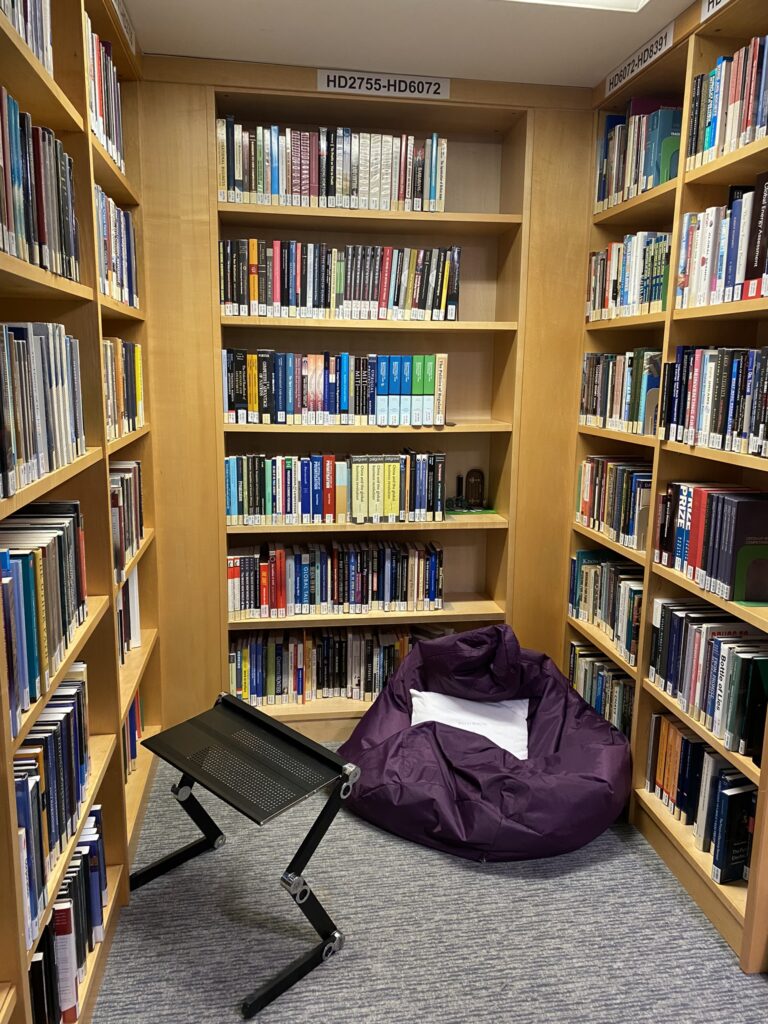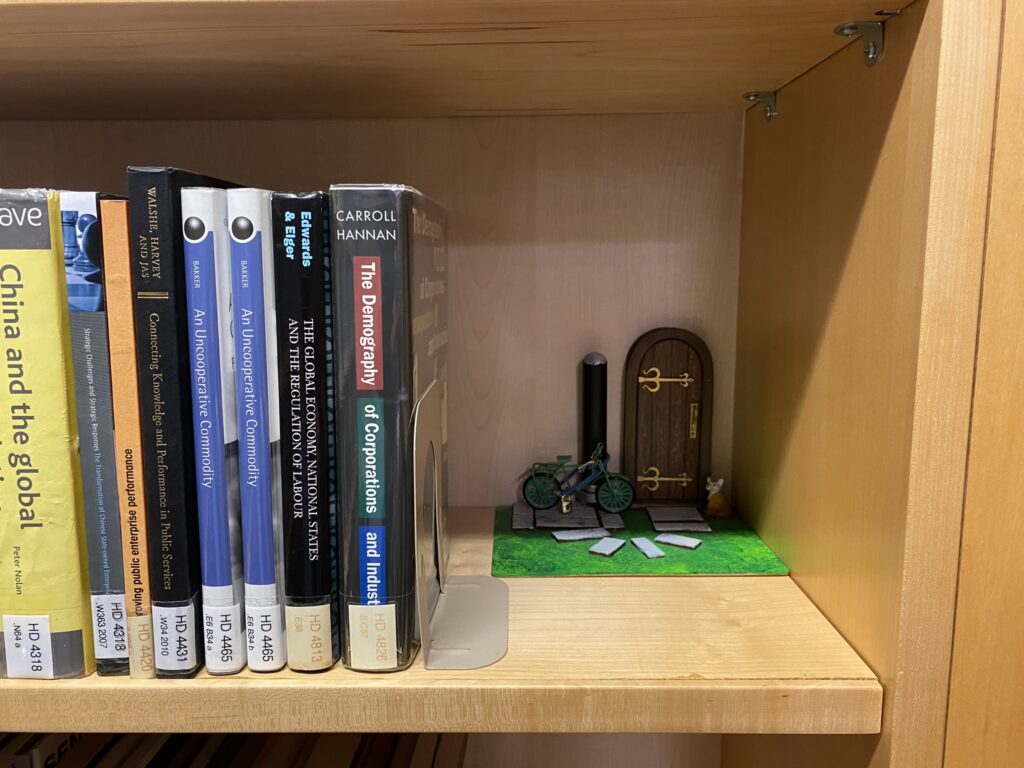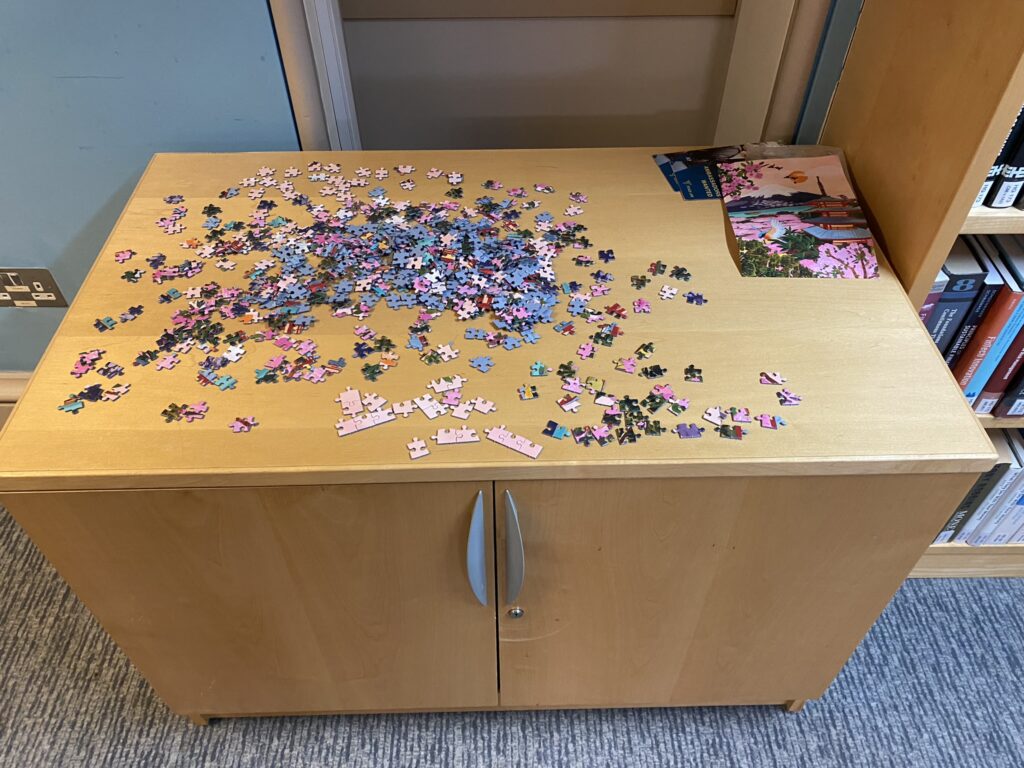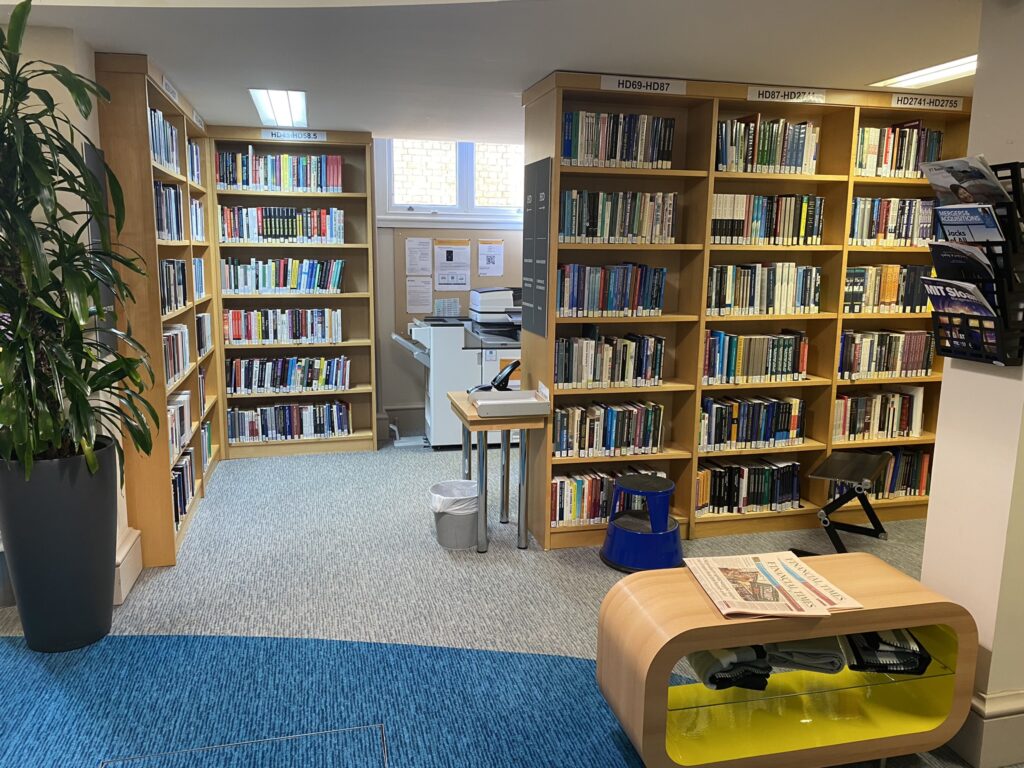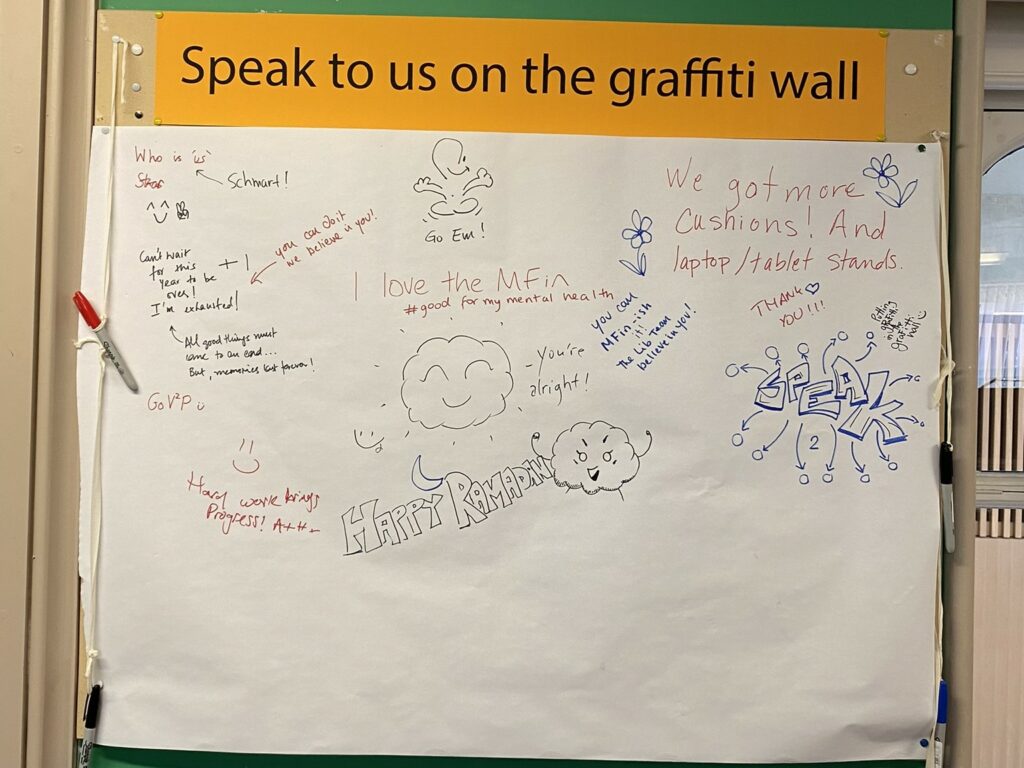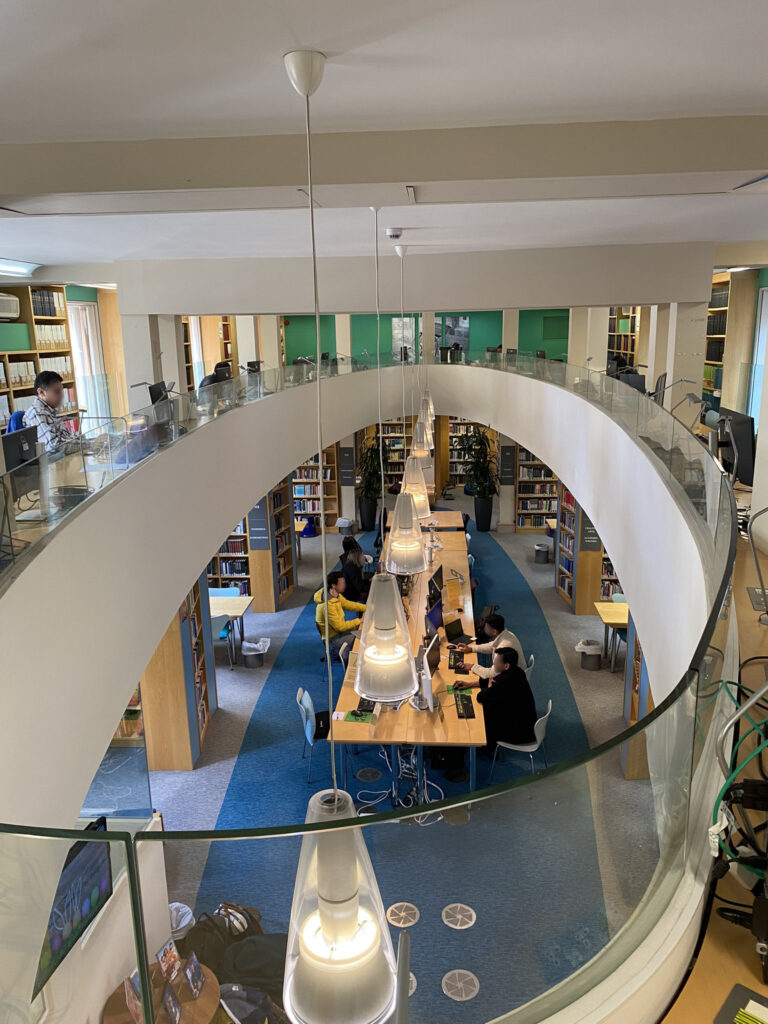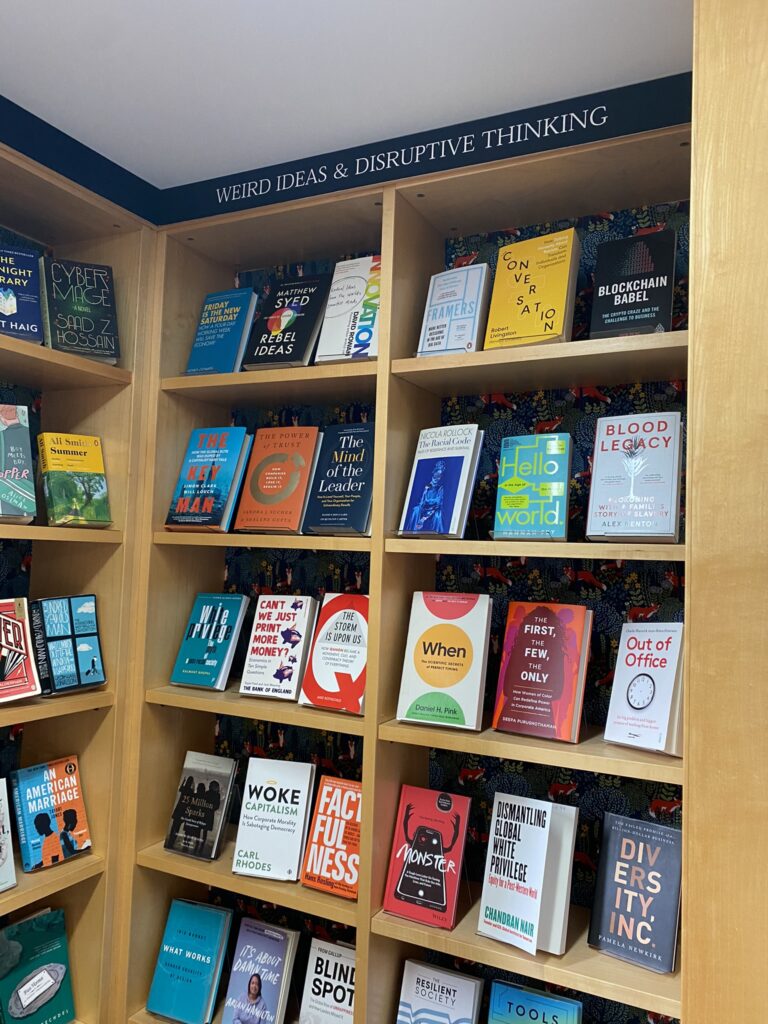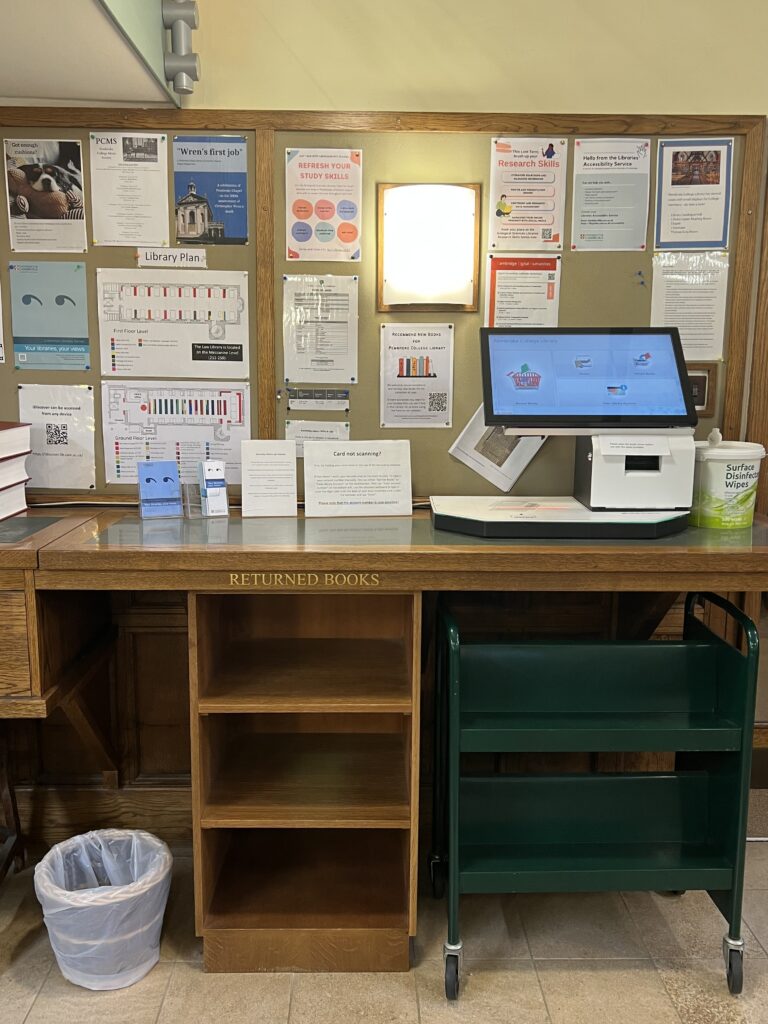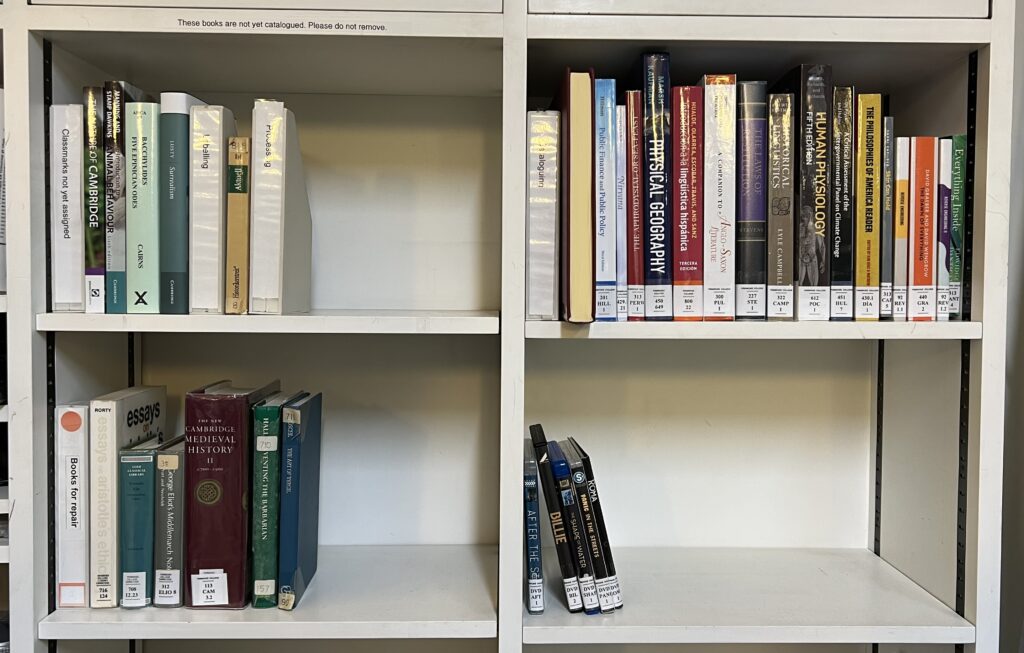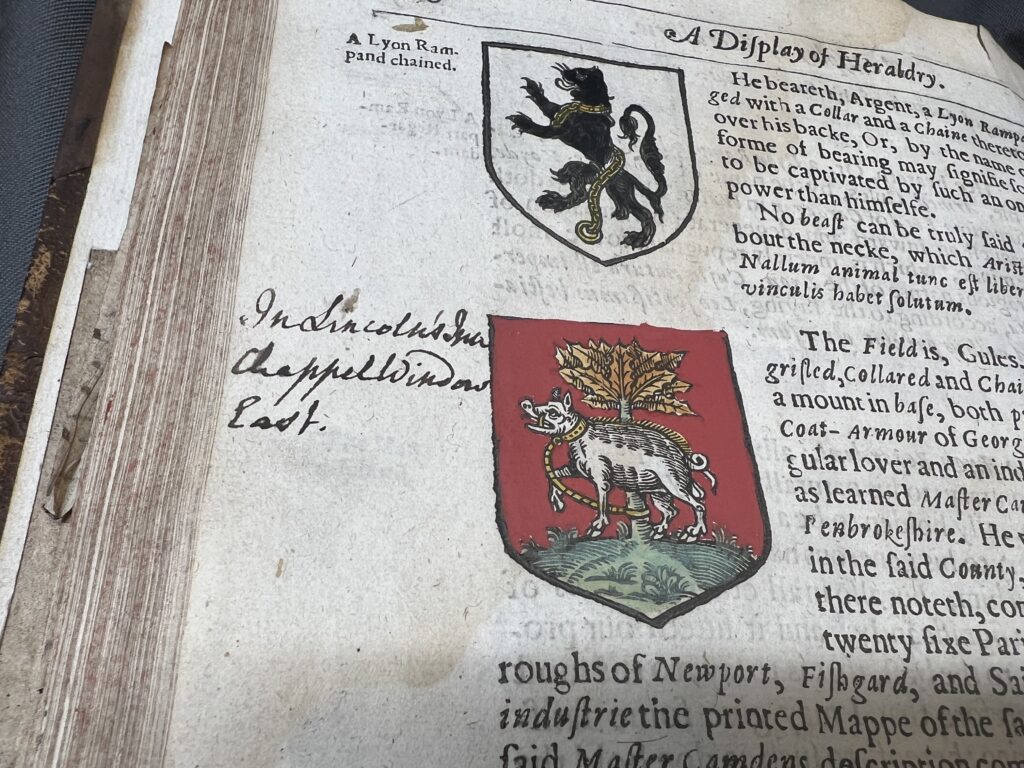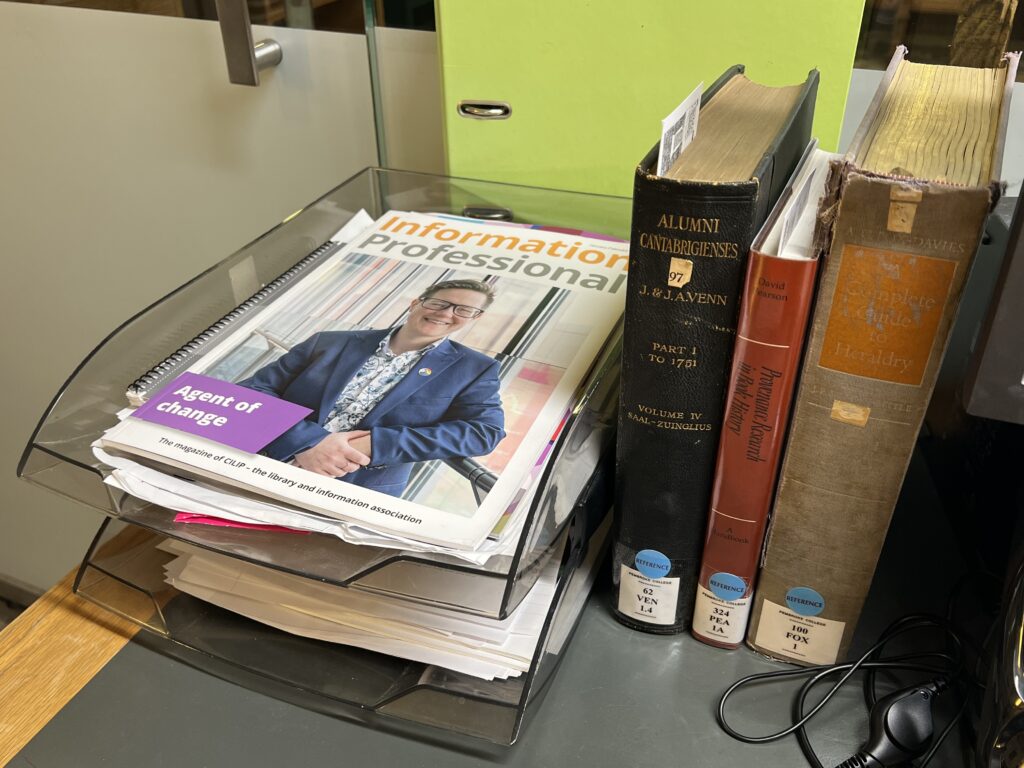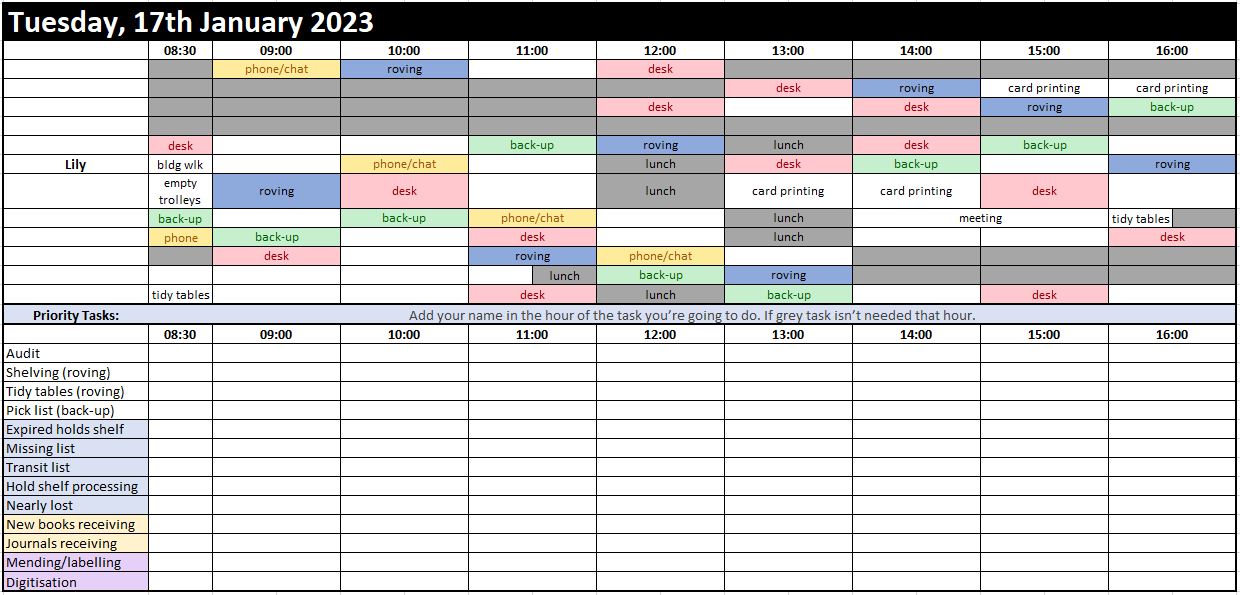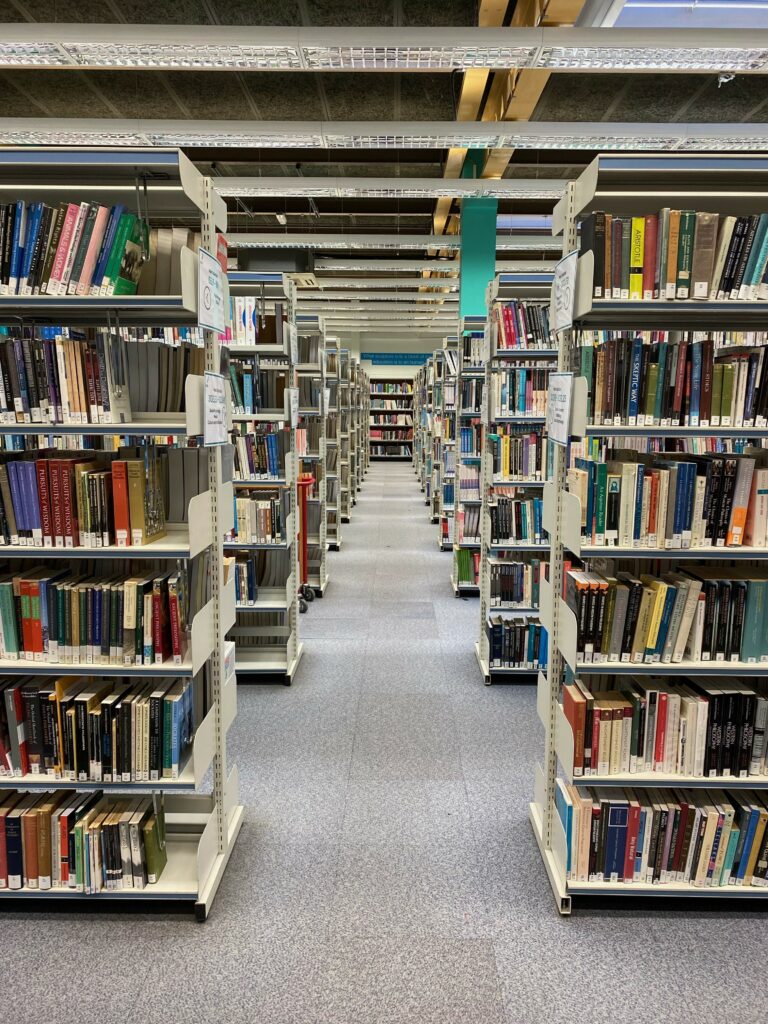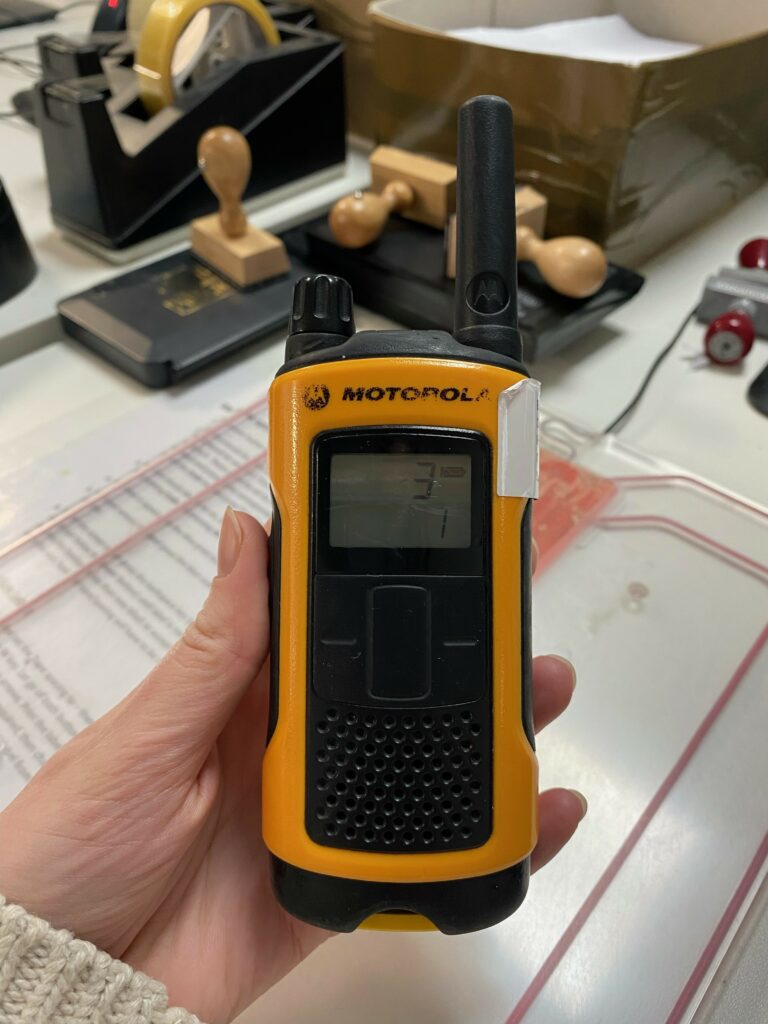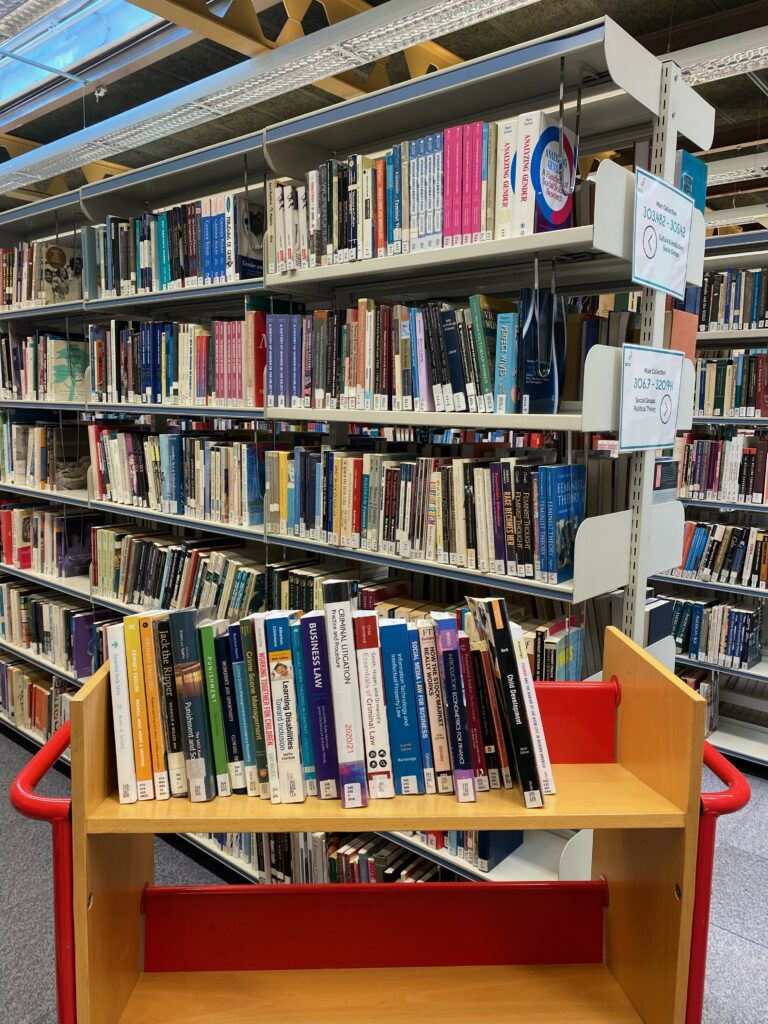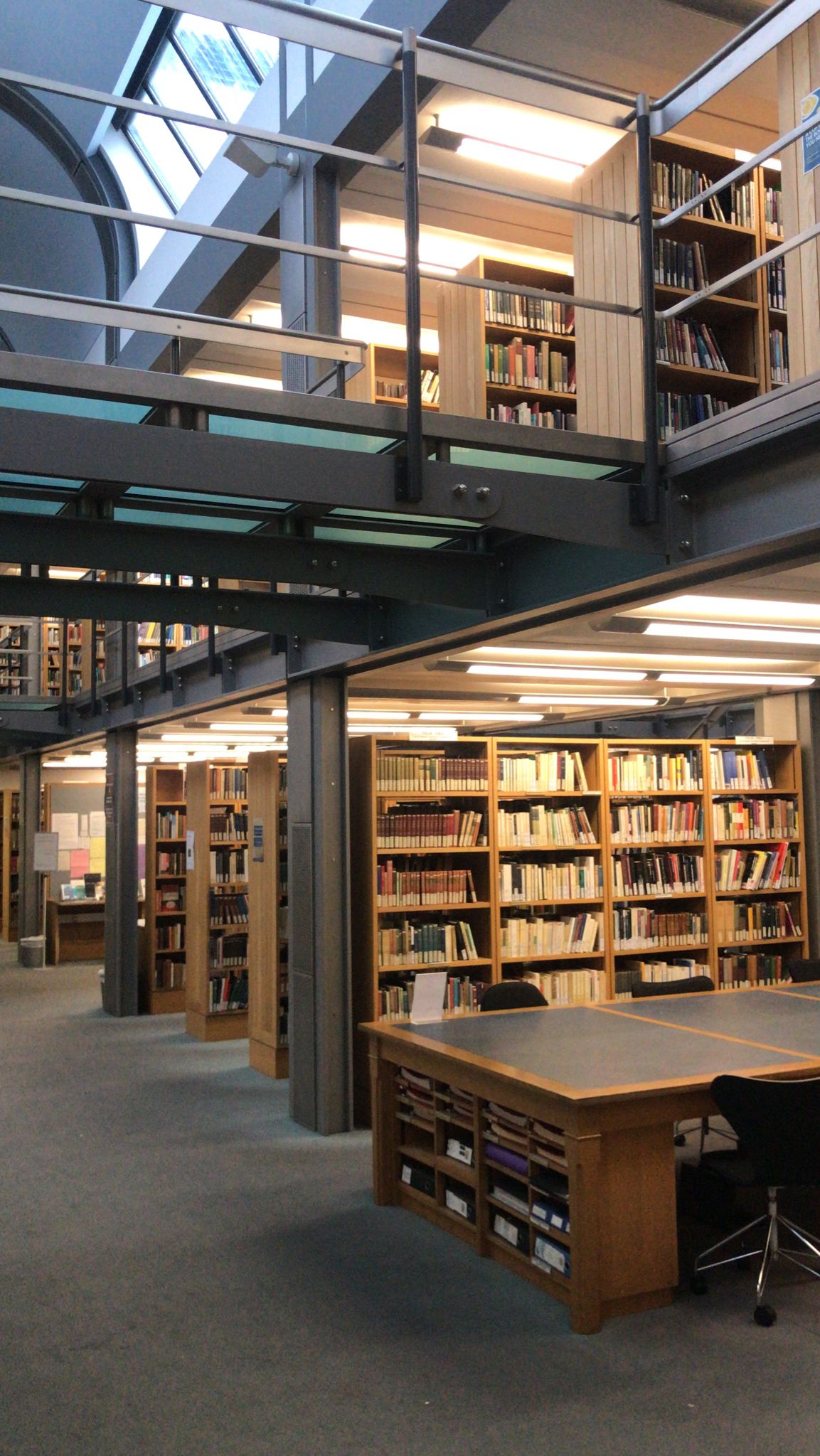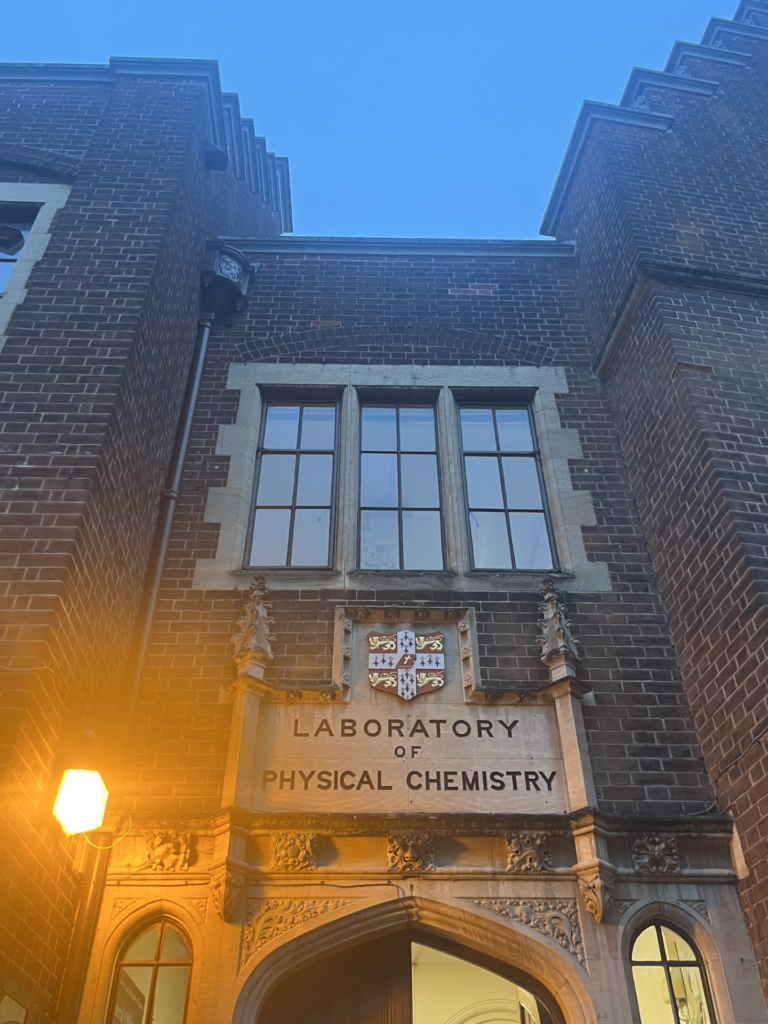

The Whipple library occupies part of the Department of History and Philosophy of Science, and is the specialist library for this faculty. It is located on Free School Lane in the centre of Cambridge (a landmark I always use to find it is Jack’s Gelato!). The street is highly Cambridge-dark-academia-esc, and we were treated to lovely views of the rooves of the city and cobble stone paths through various windows as we wandered round the library.
Passing under the ornate ‘Laboratory of Physical Chemistry’ sign, with a light beginning to cast a faint glow in the dusk, we began our visit to the Whipple Library. As the Librarian explained to us as we entered, this sign is actually a residual architectural element from their predecessors. The building now contains the library, their partner museum (The Whipple Museum), and the History of Philosophy of Science department. Both the library and museum share a benefactor – a Mr Robert Stewart Whipple. As well as being the Managing Director of the Cambridge Scientific Instruments Company from 1905, Whipple was a collector of instruments, models and books, and his donation of c. 1000 instruments and c. 1200 early printed books to the university was made with the intention to further research and teaching in the subject in the University. It is his bequeathment which the museum and library are founded upon, and which was expanded in the 1970’s with the establishment of a modern collection to compliment the historic bequest and to serve the students and researchers in the department. All of this was explained to us by the Librarian as he gave us a tour of the library. We saw how close this relationship is between the museum and library during the tour, as several museum items are housed between the books, raising questions about curation, both in terms of library space and the interaction between books and objects in exhibitions more specifically.
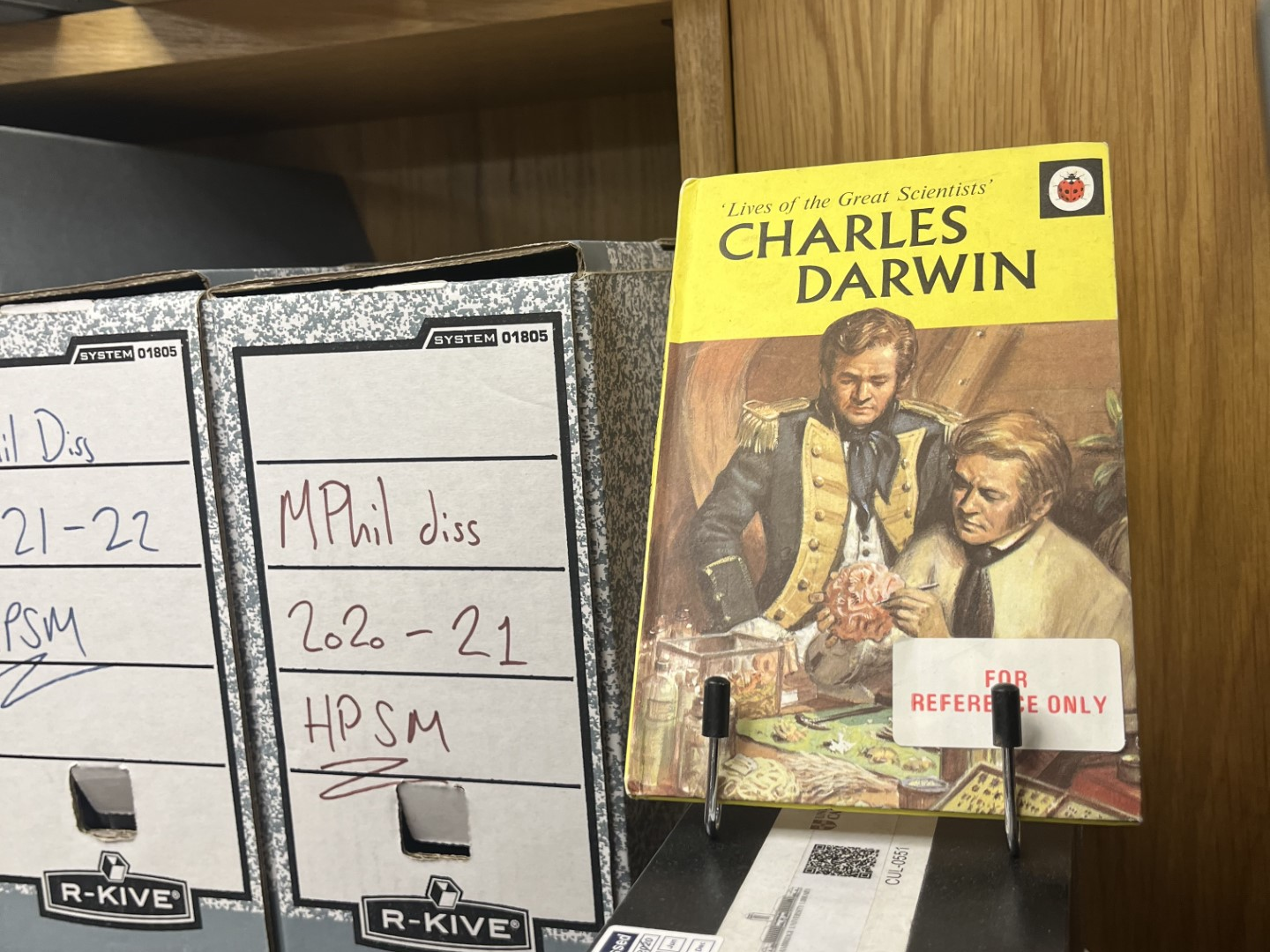
This was the first departmental library we have visited as a trainee group, but the Librarian was keen to stress the ways that the Whipple is a-typical as a departmental library. This a-typicality largely arises out of the quirks of the department, particularly in that you cannot apply to Cambridge to do an undergraduate course in History and Philosophy of Science, rather you take a route into the discipline while already a student here in later years of your degree, or at the point of postgraduate study. The librarian explained how this creates unique demands on particular resources from the library, and he explained how they respond to these challenges, for example they acknowledge and aim to help with the difficulties of transferring from a STEM subject to an essay/ critical-analysis based course and so have created an extensive collection of past dissertations and essays which students consult to develop an understanding of how to write essays effectively. The Librarian also showed us how classification has to adapt to the contents of the collection by highlighting some particularly odd and unique classifications, such as ‘Witchcraft & demonology’, which claims its space between ‘History of Chemistry’ and ‘History of Life Sciences’. There is also a Ladybird edition of Charles Darwin, which the Librarian explained is half a joke, but which he has seen students consult before! This playful energy is held throughout the library, and created a warm and friendly environment, including their “good old-fashioned” science fiction collection, which showed that Departmental libraries can stay true to their purpose and department, while also offering things that seem more unexpected. There is space for creativity when running such libraries. Oh, and, how could I forget the rubber chicken in the ‘party essentials’ box?!
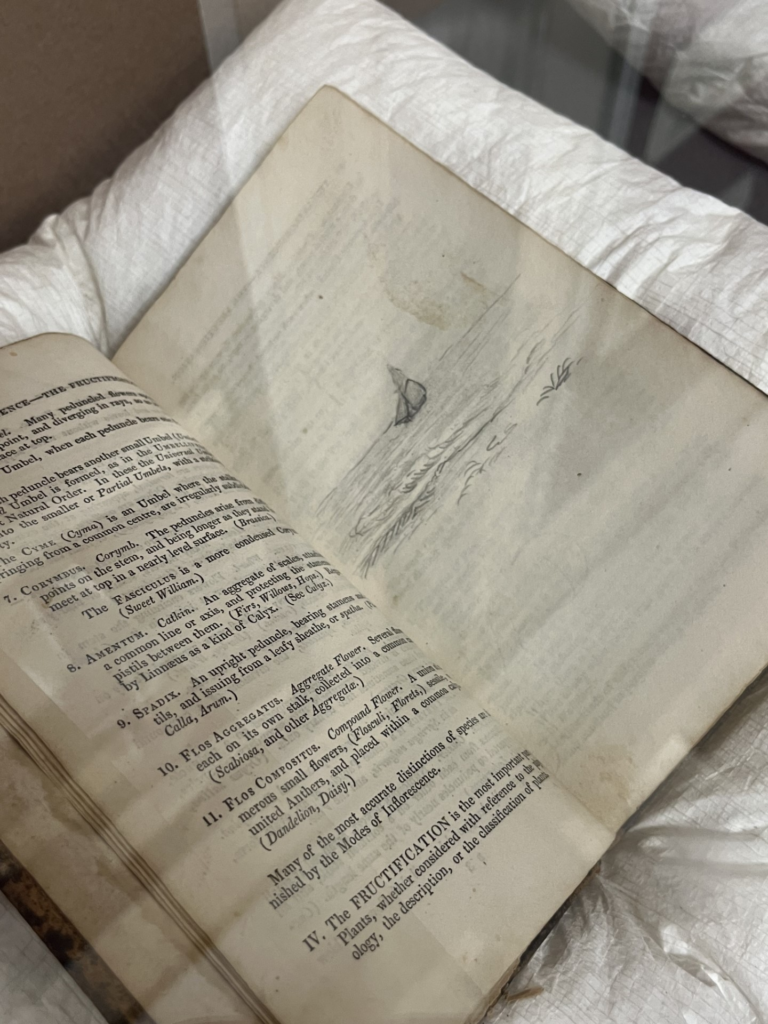
The uniqueness of the departmental make-up also influences the way that rare collections are utilised in the library. We were shown an exhibition designed by a current postgraduate student in the department, entitled ‘Discovering Past Readers’, which looks at annotations and markings of various kinds in the Whipple Rare Books collection, which also has a partnering podcast.
The exhibition ranges from markings we would typically expect, such as provenance inscriptions and notes left by readers as they work their way through the texts, but also more playful and surprising instances, like the edition of blood and a phallis in red ink to woodcuts in an astrological work [Clarissimi viri lginij Poetican astronomicon opus vtilissimu[m] foeliciter incipt], and the pressing of botanical specimens, preserved between the pages of Outlines of botony nestled alongside drawings ranging from boats to napping dogs. While looking at this exhibition we also learnt about the phenomenal Grace Young (1868-1944), who studied mathematics at Girton College, as well as unofficially sitting the Oxford mathematics exams in 1892 for which she gained the highest mark in the entire cohort. In 1895 she completed her doctoral thesis in Germany and in doing so became the first woman to ever earn a doctorate from a German University. We learnt about this incredible intellectual powerhouse of a woman while looking at her work The Theory of Sets of Points, the first textbook in English on the subject of set theory, and which contains many annotations and revisions in her hand, alongside pasted-in photos from her life – a work which was acquired through the Whipple Fund.
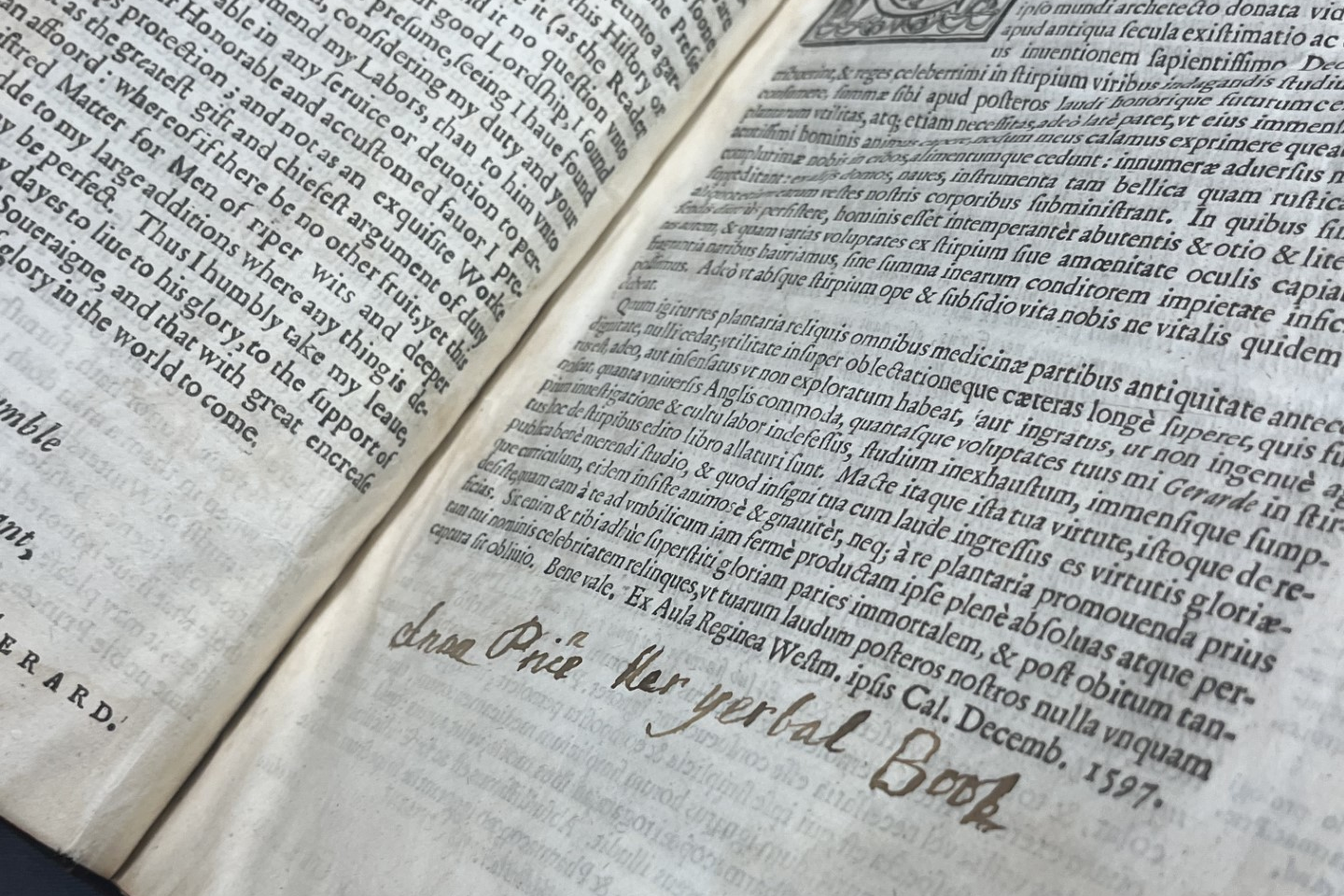
This lead to us being shown (with a fantastic amount of energy and excitement) a selection of the rare books held by the Whipple, as well as an explanation of how their rare-book collection is also unique in that they continue to acquire works relevant to the discipline, to the developments of science, or books that it is considered Whipple would have bought himself – it is a continuously growing collection. This involved the unveiling of items whih similarly had importance provenance associated with women, such as Gerard’s Herbal, with the Whipple edition previously owned and annotated by Anna Price: ‘Anna Price Her yerbal Book’. This book was a particular favourite of one of the trainees who has a particulalr interest in Renaissance gardens. We began, however, with some gems of the collection: a first edition of Galileo’s Dialogue on the two world systems, which is particularly interesting given its nature as being unbound, held in its original paper wrappers bearing a bookseller’s warehouse stock number, with its leaves uncut; works by and associated with Newton, including a direct edition of his Principa and a presentation copy of Boyle’s Tracts signed by Newton, and which also contains a secondary letter of ownership by Gilbert Regraves which shows anxiety over inscribing his name “on the page hallowed by the immortal name of Newton”. The absolute highlight was an absolutely miniscule edition of Galileo’s letter to Cristina Di Lorena, which is no bigger than a thumbnail, and which features an impressively tiny frontispiece portrait. At this point, the Librarian was getting slightly more used to being a hand model.
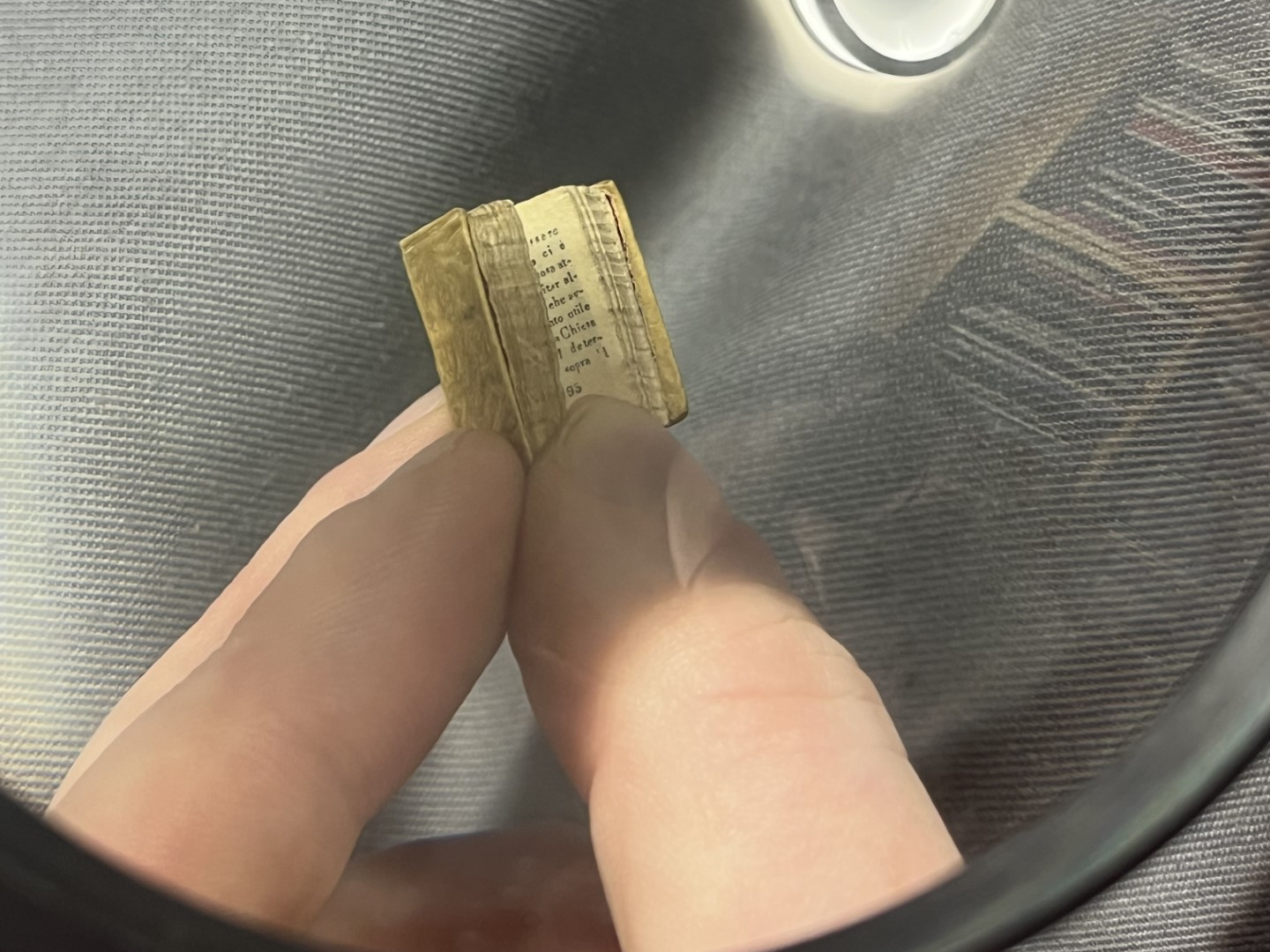
We finished off the trip with the Librarian explaining his own journey into librarianship, and his own time as a graduate trainee, which helpfully gave us suggestions as to how our own journey’s in librarianship might play out. He also explained how the library and museum participate in outreach, both through the Cambridge Festivals but also in school visits. This story was particularly moving to me as it directly echoed my own first visit to Cambridge, which instilled me with the confidence to apply here; it was a pertinent reminder of the power that libraries have in people’s lives.
We are very grateful to the Whipple Librarian for taking the time to show us around the library, to indulge our interest in the treasures of their collections, and for his kindness in offering help in our paths into librarianship.









